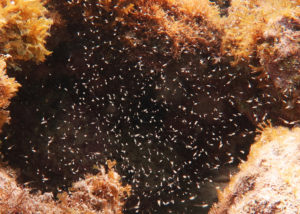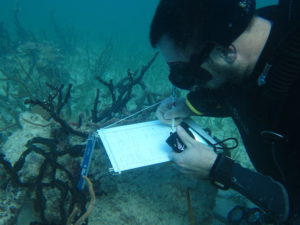An international study has found the first evidence of an animal other than humans domesticating another species.
The team led by researchers from Griffith and Deakin Universities found coral reef fish in Belize, Central America, domesticated the planktonic mysid shrimp, using them to help fertilise their algae farms.
“We found highly territorial longfin damselfish and mysids have a mutualistic relationship that benefits both,” said Dr Rohan Brooker from Deakin University’s Centre for Integrative Ecology.



“The damselfish aggressively defend a patch of reef where they farm algae for food, against all but the mysid shrimps.
“Swarms of the mysid shrimp, who benefit from the protective refuge provided by damselfish, fertilise the algal farms with their waste, improving quality of the farmed algae, and in turn, the condition of the farmer, the damselfish.”
The domestication of other species is a complex behaviour long considered to be distinctly human. While the domestication of fungi is seen in some insects, identifying examples of animal domestication by species other than humans has proven elusive.
“The field studies and behavioural experiments we conducted at Carrie Bow Cay Research Station, however, provided evidence the relationship between damselfish and mysids bares all the hallmarks of domestication, not dissimilar to how humans keep farm animals,” said Dr William Feeney from Griffith University’s Environmental Futures Research Institute.

Dr William Feeney, from Griffith University’s Environmental Futures Research Institute.
“This is the first recorded case of a non-human vertebrate domesticating another species, and the first experimental evidence for a hypothesised pathway for how this domestication evolved.”
“The relationship between the damselfish and mysids could tell us much about how we first domesticated familiar species like cats, dog, pigs, and chickens.
Dr Brooker said the ability of mysids to occupy and thrive within the refuge created by the damselfish and the habituation of these species with one another, led to the mysids domestication.
“This is not unlike the series of theoretical steps underpinning the domestication of animals by our own ancestors via the commensal pathway, where animals who were attracted to human settlements were subsequently domesticated by ancient humans.”
“It is generally food scraps or shelter that are thought to have attracted animals to humans,” Dr Feeney said.
“But, this study highlights the important role that protection from predators also plays in domestication, with mysids shrimp quickly consumed by other predators when the damselfish farmer wasn’t present.
“It reveals the fascinating insights into domestication by humans that can be gained by examining relationships between non-human organisms.”
